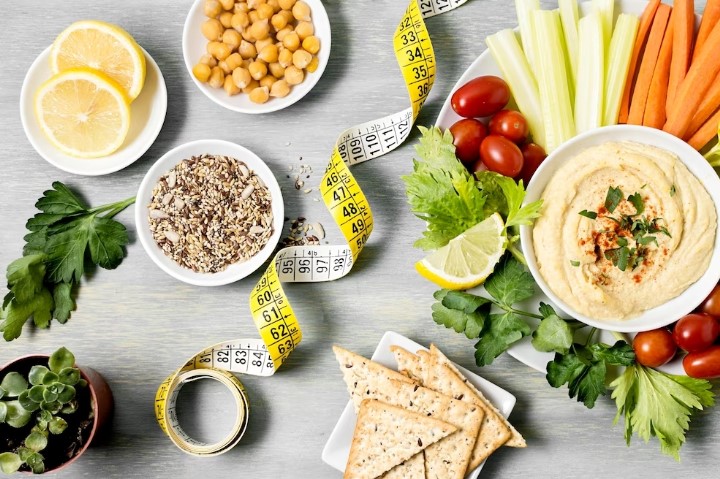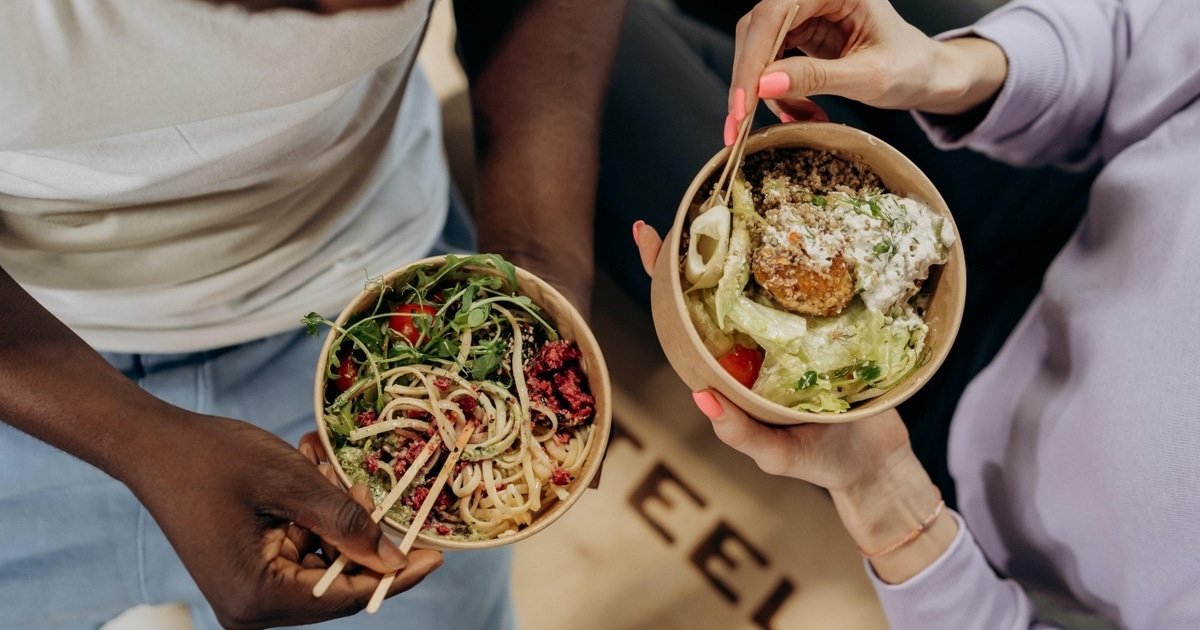
This is a roundup of advice that originally appeared in the Tufts Health & Nutrition Letter, published each month by the Friedman School of Nutrition Science and Policy. To get more expert guidance on healthy cooking, eating, and living, subscribe here.
The period from Thanksgiving through New Year’s can be a disaster for your best intentions of watching what you eat and staying active.
From rich traditional fare to behavioral cues to overeat to hosts who don’t plan for dietary restrictions, the holidays are a sort of “perfect storm” for weight gain, digestive issues, and other diet-related health problems.
“The defining characteristic of traditional holiday items like stuffing, traditional gravy and pie is that they’re all extremely high in calories and low in fiber,” says Susan Roberts, director of the Energy Metabolism Laboratory at the USDA Human Nutrition Research Center on Aging (HNRCA) at Tufts University, and author of The “I” Diet. “In other words, they’re the perfect mix of nutritional factors to make you have to eat huge amounts of these foods before you feel content and full.”
Holiday spreads also tend to include a variety of desserts. Refined white flour, added sugars (including “natural” sugars like honey, agave, and maple syrup), and saturated fats are the foundation of our favorite treats, but excess intake is also a recipe for increased risk of diabetes, heart disease, and obesity.
Even just looking at a beautiful spread amplifies the effect. “The sight and smell of abundance triggers real metabolic signals of hunger and expands our stomach so that we need to eat more to feel full,” Roberts says.
Tufts research has found that overeating “situationally” – such as during the holidays – is an important predictor of weight regain after weight loss during other times of the year, Roberts says, adding that many people seem to put on all their excess weight during this time.
The good news is, with a bit of forethought, you can go forth and partake in the festivities without making your body pay the price.
“The best way to prevent post-holiday remorse is to develop strategies ahead of time to avoid overconsumption of unhealthy food and beverages,” says Alice Lichtenstein, director of the HNRCA Cardiovascular Nutrition Laboratory, and professor at the Friedman School of Nutrition Science and Policy at Tufts. “This doesn’t mean you have to deprive yourself of holiday favorites; it just means you have to be aware of how much and how frequently.”
Here are some ways you can take control of your holiday eating, from Lichtenstein and other nutrition experts at Tufts.
Be Strategic
Be selective. You don’t have to try everything. Take an overview of everything and focus on just what you absolutely adore or what brings back happy memories. Use a small plate or cocktail napkin to control portion sizes.
Have a plan. Allot yourself a maximum amount you plan to eat each day and stick to it. Store favorite items out of sight to help resist temptation. Consider (contactless) delivery of some of that glut of holiday goodies to family or neighbors, especially those who are not able to connect with others this year, or freeze extras.
Savor the flavors. Give yourself permission to enjoy the pleasures of the holiday season. Savor each (modest) bite and smile as the flavors bring back memories of holidays past and create positive thoughts for holidays to come.
Lean In to Fruits and Veggies
At holiday feasts, it’s OK to serve traditional fare and even desserts—but shift the spotlight to fruits, vegetables, beans and nuts.
- Serve salad as a first course to help fill up before the caloric dishes hit the table. Go heavy on greens, colored veggies and healthy oils and lighter on croutons; add color, crunch and more nutrients with bits of (peel-on) apples or pears. (For Thanksgiving, skip the bacon bits and consider dried cranberries and sunflower seeds on your salad.)
- Make vegetable side dishes or at least the co-star of the main course. Try a vegetable-based soup course, like one made with seasonal squash, and seasoning such as nutmeg. Roast your vegetables, which brings out their natural sweetness while better retaining nutrients otherwise left behind in the boiling water.
- Work in cranberries. In addition to dietary fiber and vitamins A, C and E, cranberries are among the richest source of phytonutrients such as anthocyanins, ellagic acid and quercetin. Add less sugar. Unfortunately, the standard cranberry sauce recipe on the back of the bag adds a whole cup of sugar to each 12-ounce bag of berries, so a half-cup serving tops 200 calories. You can keep your cranberry sauce more tangy by adding less sugar. Work cranberries into different holiday recipes where other fruits can help sweeten them or they add a tart touch to savory foods.
Make Healthy Substitutions
- Go pescatarian. Consider centering your meal on fish, like salmon, instead of other meats, or at least have fish as a second choice.
- Swap sweet potatoes in for regular potatoes. You’ll find several varieties in the supermarket, including “yams” that are actually sweet potatoes, too. All are excellent sources of vitamin A, potassium, dietary fiber and vitamin C. You’ll also get magnesium, phosphorus, choline, iron and calcium – and just 180 calories per cup of cooked sweet potato.
- Substitute buttermilk for the butter and cream in your mashed white potatoes and reduce the portion size. Or try roasting baby potatoes that are now available in a rainbow of colors—a sign that they are rich in pigment phytonutrients.
- Substitute olive oil for butter. Making cakes and other baked goods with oil instead of some or all of the butter boosts the healthy unsaturated fat and shifts the balance away from the saturated fat, according to Lichtenstein. It also has the added benefit of producing a moister, more tender cake.
- Reduce the amount of white flour. “Substituting at least half the white flour with white whole wheat flour (or regular whole wheat flour) or replacing some of the white flour with almond flour is another way to improve the dietary quality of desserts,” says Lichtenstein. “Just be aware that almond and other non-wheat flours will impact the texture of your baked goods.” She adds, “Adding chopped walnuts or sunflower seeds will add interesting texture and increase fiber, which may lead to a more moderate portion size.”
- Cut that sugar. Sugar contributes to tenderness, texture, browning, and aeration, so cutting it will impact more than just sweetness. Still, leaving some of the called-for sugar out of most recipes will change them, but not ruin them. If you want to cut sugar (or introduce sugar substitutes) in a recipe, you should plan to experiment. Conventional wisdom recommends not cutting more than a third of the sugar, but some recipes can handle more. (If sugar plays an integral role—such as in merengues or candy, or even a simple yellow cake—cutting is not really an option.)
Portion Power
Whatever your holiday menus, keeping your seasonal eating healthy also means practicing portion control.
- Know your serving amounts. A “serving” is the amount of food recommended in consumer education materials such as MyPlate or used in Nutrition Facts labeling. A “portion” is the amount of a food you choose to eat at any one time – which may be more or less than a serving but is typically more. When cooking at home for the holidays, dish up the recommended serving to each member of the family.
- Keep leftovers off the table. Leave the leftovers in the kitchen rather than putting on the table, so second helpings require a bit more effort. Refrigerate leftovers promptly after the meal, both to prevent foodborne illness and to discourage after-dinner snacking.
- Serve small desserts. Prepare or package homemade and store-bought desserts into modestly sized portions. Mini muffin tins, tiny cookie cutters, mini cake and loaf pans, the smallest cookie scoop, or just a knife make it easy to serve bite-sized desserts. Offering a taste relieves the implied commitment and real temptation to eat that full slice of double chocolate cake. Plus, it stretches recipes—a dozen cupcakes become 24 or more mini muffins, which means more to share, gift, or freeze.
Be a Health-Conscious Host
- Ask what people can and can’t eat. If you’re hosting the meal and aren’t already familiar with guests’ dietary needs, just ask.
- Consider serving the meal buffet-style. You can include a mix of traditional favorites and diet-friendly dishes.
- Offer simply-prepared dishes. “Dishes with fewer ingredients make it easier for guests to know what they’re eating, and such dishes tend to be healthier, too,” Kane says.
- Serve toppings on the side. “If a dish has a gravy or sauce, serve it on the side so guests can decide whether or not they want to include it,” Kane says.
- Keep recipes handy. If people are bringing dishes to share, ask them to write their name and the recipe (or at least the ingredients) on a recipe card to place by the dish.
- Retain product details. “Keep food package labels of what you’ve used to prepare menu items so guests with allergies can double-check ingredient lists,” Romano says. Or, snap photos of the packages (including the complete ingredients list) on your smartphone.
- Offer some non-alcoholic but festive drinks. Many recipes for “mocktails” (non-alcoholic mixed drinks) can be found online. Flavored (unsweetened) sparkling water can be festive, too.
- Consider meal timing. Tell guests what time the meal will be served, especially if it’s outside the norm, like mid-afternoon. Guests with diabetes may need to plan ahead. Consider serving some healthful appetizers, like fresh vegetables with hummus dip.
- Share the menu in advance. “It can help to give guests an idea of what will be served so they can plan appropriately,” Kane says.
- Watch the salt. Add minimal salt to dishes, letting guests add more if desired. Opt for low-sodium or reduced-sodium ingredients when you can.
- Be carbohydrate-aware. Carb-conscious guests will appreciate non-starchy vegetable offerings like a pretty salad of mixed leafy greens or roasted Brussels sprouts.
- Opt for vegetarian or vegan ingredients, when you can. If a recipe like stuffing, soup or a side dish calls for broth, opt for vegetable broth rather than chicken broth.
- Make hearty side dishes that do double-duty as a vegetarian or vegan main dish. For example, try quinoa pilaf with dried cranberries and roasted squash, or make a baked bean dish or three-bean salad.
Savvy Socializing
- Stick to your normal meal schedule on a party day, says Roberts. Before you go, eat a healthy, high-fiber snack like raw vegetables, nuts or fruit to take the edge off your appetite.
- Offer to bring a dish and make it a healthy one. Your host will appreciate the help and you’ll know you have something good-for-you to eat.
- Become a vegetarian. Holiday parties are also a smart time to suddenly, even if temporarily, eschew meat.
- Watch where you stand. Don’t be one of those guests who stays planted by the buffet table. Stand more than an arm’s length away from the food and snack bowls, Roberts suggests, so you aren’t unconsciously reaching for more while you chat. “Multiple research studies have shown that the proximity of food determines how much you load onto your plate,” she notes.
- Pass the platter. At sit-down dinner parties, keep the less-healthy foods and alcohol moving down the table away from you, and make sure they don’t end up within easy reach.
- Never eat a treat alone. “Always eat your treat accompanied by a healthy food,” Roberts says. “For example, if your treat is chips, try eating them with a yogurt dip and some red-pepper slices and celery.”
Guidelines for Guests
Special dietary needs shouldn’t divide us at the holiday table. All it takes to come together and enjoy each other’s company over a meal is good communication, a bit of understanding and pitching in to help as needed.
- Give your host a heads up. As soon as you’re invited, let hosts know your diet restrictions, so they don’t have to scramble at the last minute or feel hurt if you don’t eat their special dishes.
- Offer to bring a dish. Consider bringing a one-pot-meal, such as a hearty salad or casserole. This ensures there’s something you can eat, without making hosts prepare something special for you.
- Applaud well-intended efforts, but be honest when they won‘t work for you. If someone makes a casserole, for example, but overlooks the gluten in the condensed soup in the dish, thank them but don’t risk your health by eating it.
- Polish your elevator speech. You might be put on the spot to explain why you’re passing up certain dishes. Or, guests may ask why you’re eating something they think you shouldn’t have. Kane suggests saying something like, “Thanks for your concern, but this is what works best for me.”








